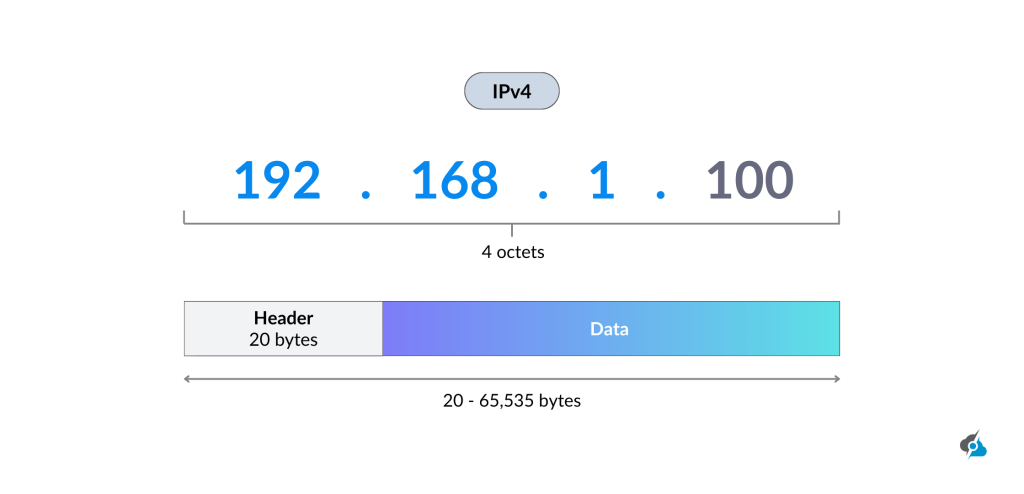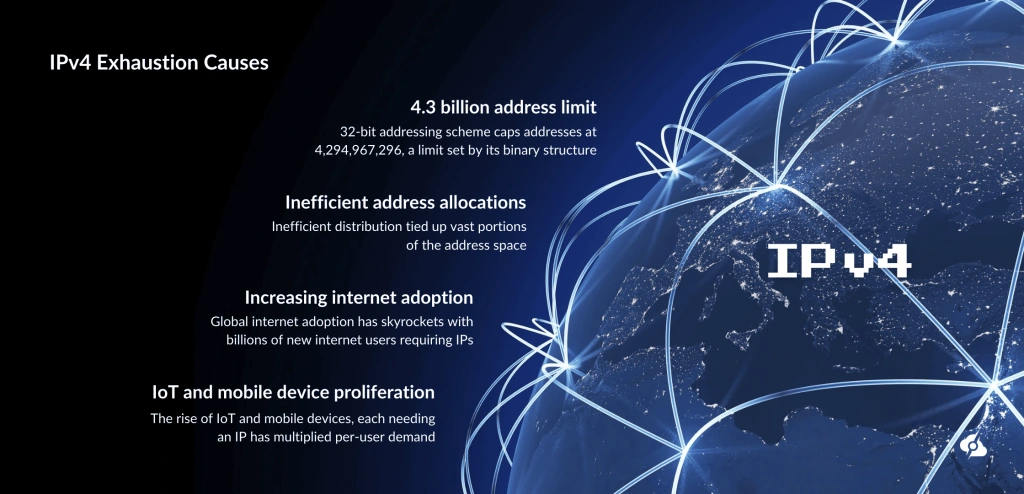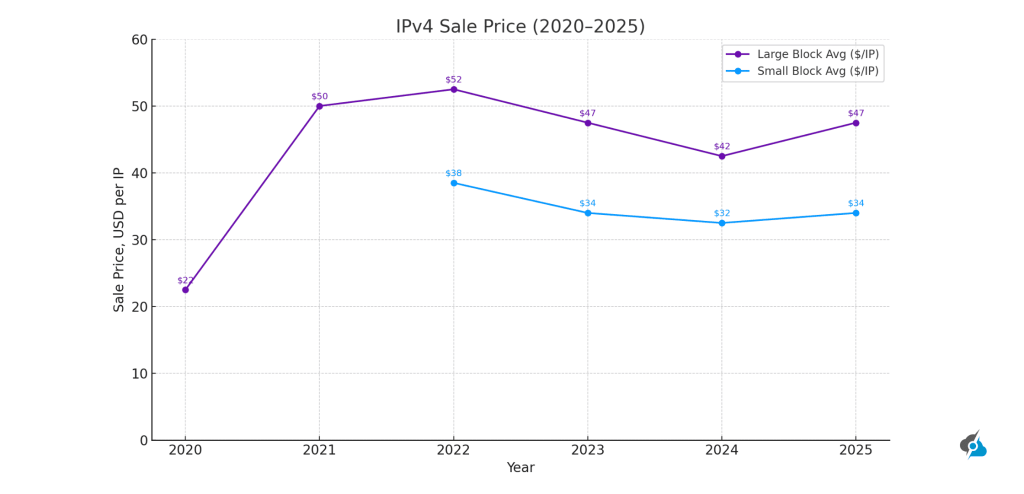IPv4 Exhaustion Explained: Causes, Factors, Impacts, and Solutions for Organizations

In 2025, IPv4 exhaustion in the internet today is not just a threat, it’s a business operation crisis.
IPv4, the internet’s foundation, still relies on a 1980s design, under the weight of billions of devices, each requiring assigned IP address. IPv4’s dotted decimal notation only provides 4.3 bullion unique addresses which are long gone, leaving organizations solely relying on solutions and workarounds.
ServerMania comes in as a leader in networking solutions and IP resource management. Since 2008, we’ve mastered a future-proof approach, blending IPv4 conservation with seamless IPv6 integration. We offers businesses a solution—IP leasing, dedicated server hosting, and IaaS cloud hosting that keep networks on track in the IP demanding networking world.
This article goes beyond IPv4 exhaustion, exploring impacts, and solutions, revealing how ServerMania is laying the foundation for a future-proof networking.
What is Address Exhaustion
IPv4 address exhaustion refers to the depletion of the IPv4’s small pool of roughly 4.3 billion unique addresses, which is an issue foreseen since the 1980s. The crisis arose due to the wider internet as many always on devices started to flood the internet, that kept needing more and more addresses.
Managed globally by the Internet Assigned Numbers Authority (IANA), the internet numbers of the IP address space ran dry by January 2011. The Regional Internet Registry (RIRs) like APNIC (2011) and ARIN (2015) exhausting their pools, pushing the IPv6 transition as a successor protocol to sustain Internet growth.
This shortage motivated addressing group to release innovations such as Network Address Translation (NAT) and Classless Inter-Domain Routing (CIDR) in the 1990s, yet the rise of connected devices outpaced these fixes. While internet service providers recycle recovered addresses, the IPv4 pool, is not nearly enough for the ever-expanding internet infrastructure.
What is IP Address Space?
The internet protocol version 4 allocated space is the total set of unique identifiers, for example IPv4’s 32-bit addresses is limited to 4.3 billion unique IPs.
So, each address enables a device to directly communicate, but IPv4 address exhaustion highlights the urgency of this space, pushing the public internet community to implement IPv6s vast address pool.

IPv4 Exhaustion in 2025
In 2025, IPv4 exhaustion is still a crisis for companies.
That pool of 4.3 billion addresses has been exhausted for years and businesses are stuck into pricey address markets or leaning on Network Address Translation (NAT). Regional registries are doing their best, recycling whatever IP addresses they can find, but it’s not enough.
Prices for broadband connections are skyrocketing, and for many, growing their networks feels like a hurdle. IPv6 is finally starting to catch on, but too slowly to offer a long-term solution.
Quick Fact: More than 50% of organizations worldwide are still entangled with the IPv4 usage, limitations and shortage.
History and Timeline of IPv4 Exhaustion
Way back in the late ’80s, as the internet exploded, the ripe community started to get worried because the IPv4’s 4.3 billion addresses started to sound not enough. That motivated the push for IPv6 and a bunch of methods for recycling, and delaying the exhaustion.
Original IPv4 Design and Limitations:
IPv4, released in the ’80s with a 32-bit system, introduced a hard cap at 4.3 billion combinations. It was a lot back when the internet was just an experiment. However, once the world jumped online, the issue became evident and by the ’90s, the Internet Engineering Task Force (IETF) knew they had to act fast.
IP Version 4 Exhaustion by Regions:
- APNIC (Asia-Pacific): By April 14, 2011, APNIC was down to its last addresses. They started to decrease usage (1024 addresses per member).
- RIPE NCC (Europe): On September 14, 2012, RIPE NCC’s IPv4 pool ran out and Europe had to scramble and recycling old addresses to stay connected.
- LACNIC (Latin America and Caribbean): June 10, 2014, marked the end for LACNIC’s IPv4 pool and they were left with barely enough for emergencies.
- ARIN (North America): September 24, 2015, was when ARIN run dry and most North American companies joined the trading and reusing addresses.
Current IP Exhaustion Status Across All RIRs
Wondering have we run out of IPv4 addresses and when will we run out of IPv4 addresses entirely?
So, by 2025, all five Regional Internet Registries (RIRs) have depleted their IPv4 pools, retaining only minimal reserves for purposes like IPv6 transition. Organizations now depend on address transfers or recycling to secure only a small fraction of allocated IP address blocks.
Timeline Visualization:
- 1980s: IPv4 launched with 32-bit addressing.
- 1980s: Internet growth sparks depletion worries.
- 1990s: The IP version 6 development starts.
- 2011: IANA distributes final IPs; APNIC nears exhaustion.
- 2012: RIPE NCC runs out of remaining addresses.
- 2014: LACNIC’s used it’s last remaining addresses.
- 2015: ARIN exhausts its addresses.
- 2017: AFRINIC hits exhaustion phase.
- 2025: All RIRs operate with reserves and transfers.
The Primary Causes for IPV4 Exhaustion
IPv4 depletion is a technical challenge deeply in the IPv4 protocol’s design. Its addressing system, historical allocation practices, and the surge in connected devices have strained the finite pool of 4.3 billion addresses, pushing network infrastructure to its limits.
1. The 4.3 Billion Address Limit
The IPv4 protocol’s 32-bit addressing scheme caps addresses at 4,294,967,296, a limit set by its binary structure. As the Internet outgrew its experimental roots, this finite pool became a bottleneck, accelerating IPv4 address exhaustion and spurring the IPv6 transition.
2. Inefficient Address Allocations
Early Internet allocations were wasteful, with large organizations receiving /8 blocks—millions of addresses, many of which remain underused. This inefficient distribution tied up vast portions of the address space, leaving smaller entities scrambling for IPs.
3. Increasing Internet Adoption
Global Internet adoption, especially for the top million websites in developing regions, has skyrocketed, with billions of new internet users requiring IPs. This address uptake surge outpaced everything, rapidly depleting the IPv4 pool and straining network infrastructure.
4. IoT & Mobile Device Proliferation
The rise of IoT and mobile devices, each needing an IP has multiplied per-user demand. The many new internet users, hundreds of millions mobile phones, and gadgets have created immense pressure on the IPv4 system, far beyond its intended capacity.

IP Address Exhaustion Impact on Organizations
IPv4 exhaustion drives up costs and disrupts operations for organizations. The main drawback being prices in the transfer market hit $50 per address, while carrier grade NAT slow private networks down.
Providers face allocation struggles with IP address blocksin private networksand scaling issues, while hosting companies see performance drops, and cloud providers meet their growth limits, with Asia-Pacific and Africa most affected.
Key Impacts:
- Rising costs of IPv4 addresses: Transfer market prices reach $50 per public IP address, pressuring small business budgets.
- Operational network challenges: NAT and CGNAT create latency, complicating expansion for IT teams.
- Multi-tenant hosting limitations: Hosting firms lack one public IP address per tenant, causing tenant performance to suffer.
- Cloud expansion constraints: Cloud providers struggle to scale internet access without sufficient IP address availability.
- Regional variations in impact: Central Asia, Asia-Pacific and Africa face worse shortages than North America and Europe.
IPv4 Address Market in 2025
The IPv4 address market in 2025 is the result from never ending networking growth. As organizations struggle with IPv4 address exhaustion, the regional internet registry-managed market for buying, selling, and leasing IP addresses has become a critical resource.
2020-2025 IPv4 Pricing:
- 2020: IPv4 prices rose steadily, with large blocks (/16 and larger) averaging $20–$25 per address, driven by growing demand and limited supply.
- 2021: Prices spiked to $50 per address for large blocks due to heightened demand and scarcity, particularly in North America.
- 2022: Smaller blocks (/17 and smaller) saw a brief price drop to $35–$42 per address, while large blocks remained at $50–$55.
- 2023: Prices for large blocks stabilized around $43–$52, with smaller blocks declining to $32–$36 as supply briefly increased.
- 2024: The market saw a 17% price correction, with large blocks settling at $40–$45 and smaller blocks at $30–$35, resulting from a rebalancing phase.
- 2025: Prices have stabilized, with large blocks trading at $45–$50 and smaller blocks at $32–$36, as demand for smaller subnets grows.

Regional Variations in Pricing:
- North America (ARIN): High demand and limited supply drive prices for large blocks to $45–$50 per address, with a well-developed secondary market.
- Europe (RIPE NCC): Prices for large blocks in Europe and the middle east are slightly lower at $40–$45, influenced by a mature IPv6 infrastructure and active address recycling.
- Asia-Pacific (APNIC): Rapid technological growth pushes prices to $50–$55 for large blocks, with intense competition for scarce resources.
- Latin America (LACNIC): Prices hover around $35–$40 for large blocks, reflecting slower IPv6 adoption and reliance on transfers.
- Africa (AFRINIC): Limited IPv6 uptake and delayed infrastructure development keep prices at $30–$35 for large blocks, with fewer transactions.
Tips for Buying IPv4 Addresses and Market Forecast
When navigating the IPv4 address market, organizations should consider the following tips to secure IPv4 addresses efficiently:
- Block Size: Smaller blocks (/24 to /17) and larger class B block sizes are more abundant and often cheaper per address, ideal for incremental growth.
- RIR Policies: Each Regional Internet Registry (RIR), guided by the ripe community in Europe, has unique transfer rules, so consult brokers familiar with regional compliance.
- IPv4 Leasing: Leasing IP addresses gives flexibility without upfront cost of purchase, suitable for small-scale projects or market expansions.
- Market Trends: Prices fluctuate based on supply and demand, so buyers with flexible timelines can wait for better rates, while sellers should time their sales.
What to Expect in the Future?
The IPv4 market is expected to see price increases of 5–10% annually, driven by continued demand and slow IPv6 adoption. Smaller blocks will remain in high demand for regional networks, while large blocks may see tighter supply, pushing prices upward.
Top 4 IPv4 Exhaustion Prevention Methods:
With IPv4 addresses exhaustion, organizations need clever ways to maximize their use and extend the exhaustion as much as possible. So, we has prepared a few methods that can delay the exhaustion and set the foundation for IPv6 adoption.
1. Network Address Translation (NAT)
NAT or Network Address Translator allows multiple devices to share one publicly routable address, using port forwarding for mapping private addresses to it. This reflect reasonable usage reduces demand for public IPs, stretching availability for customer networks.
2. CIDR and Efficient Subnet Design
Classless Inter-Domain Routing (CIDR) offers flexible IP address allocation, reducing waste from rigid class systems. Smart subnetting with static IPs ensures addresses meet requirements, against the IPs insufficient capacity.
3. IP Address Management Solutions
IPAM tools monitor and manage IP usage, preventing over-allocation. They track the assignments and highlight unused IPs, optimizing resources for any organization.
4. Address Reclamation Techniques
Reclaiming unused IPs in private networks and local network through audits or automated tools frees up forgotten IP addresses. It’s a simple yet effective way to reuse existing stock without new allocations.
So, are we out of IPv4 addresses? Not exactly!
IPv6 Transition Progress and Strategies
In 2025, IPv6 adoption has made significant incline, with over 40% of global internet traffic now using IPv6, adopted by major ISPs, cloud providers, and mobile networks. However, the transition remains uneven, with regions like Asia-Pacific and Africa lagging due to their major infrastructure challenges.
Organizations worldwide are increasingly adopting IPv6 to future-proof their networks, yet many still rely on IPv4, which poses incompatibility issues and concerns.
Dual-Stack Implementation
The dual-stack is the most straightforward approach, allowing networks to run both IPv4 and IPv6 simultaneously. This method ensures compatibility with legacy systems while gradually migrating to IPv6. Key considerations include:
- Resource: Dual-stack requires resources, on the main internet router for both protocol support.
- Security: Separate policies for the IPv4 and IPv6 are essential against potential security issues.
Tunneling Mechanisms
Tunneling enables IPv6 traffic to traverse IPv4 networks, facilitating connectivity where native IPv6 is unavailable. The common mechanisms includes:
- 6to4: Automatically tunnels IPv6 packets over IPv4 networks through the internet interface.
- 6rd (Rapid Deployment): A variant of 6to4, optimized for service providers to deploy IPv6.
- Teredo: Allows IPv6 connectivity for viable internet hosts through NAT, used by consumers.
Translation Technologies
Translation technologies bridge IPv4 and IPv6 networks, ensuring interoperability during the transition.
- NAT64: Translates IPv6 packets to IPv4, allowing IPv6-only devices to access resources.
- DNS64: Works with NAT64 to map IPv4 addresses to IPv6 for seamless name resolution.
Sample Transition Planning Framework
Organizations should follow a phased approach to ensure a smooth transition:
- Assessment: Test usage on network equipment to identify IPv6 systems.
- Pilot Testing: Test via deploying IPv6 on existing hardware on a small scale.
- Training: Educate admins on IPv6 configuration and troubleshooting.
- Deployment: Gradually expand IPv6 across the major networks.
These strategies provide a clear path for organizations to navigate the IPv6 transition!
Is There a Long Term Solution to IPv4 Exhaustion?
Beyond migration to IPv6, there is no long-term solution to IPv4 address exhaustion, as the protocol’s 4.3 billion IP addresses simply can’t keep up with today’s global demand. IPv6, with its expansive 128-bit address space, stands alone as the ultimate fix, offering enough IPs to support truly endless growth.
Yet, with IPv6 adoption lagging, organizations turn to hybrid solutions to manage the shortage. These aren’t permanent answers but practical methods to stretch IPv4’s lifespan.
- IPv4 Conservation + IPv6 Adoption: Maximize IPv4 use with tools like NAT and CIDR while phasing in IPv6 for a smoother transition.
- Cloud-Native Networking Approaches: Leverage virtual networks and software-defined solutions to optimize IP usage and reduce IPv4 dependency.
- Carrier-Grade NAT Considerations: Share public IP addresses across internet users via CGNAT, though it may add latency and management challenges.
- Edge-Specific Addressing Strategies: Use private IPs and tunneling at the edge to conserve public IP addresses for essential needs.
What is the Future of IPv4 Address Exhaustion?
The future of IPv4 doesn’t seem bright as exhaustion is no longer a threat but a current reality, with Regional Internet Registries (RIRs) having depleted their pools by 2025. They now rely on recycled IPv4 addresses and transfers with $45–$50 per address for large blocks, with smaller blocks at $32–$36.
Looking forward, organizations face a big dilemma: the rising cost of IPv4 addresses or the significant investment in IPv6 infrastructure.

ServerMania’s Solution Against IPv4 Exhaustion
Despite the global IPv4 shortage, ServerMania maintains a strategic inventory of IPv4 address blocks to meet client needs. Through careful management and partnerships, we ensure that businesses can secure the addresses required for their operations without the hassle of navigating the complex market.
IP Leasing Options
Recognizing the high cost of IPv4 addresses, ServerMania offers flexible IPv4 leasing options. Clients can access the addresses they need on a temporary or long-term basis, scaling their IP resources with business growth while avoiding big upfront costs. Leasing provides an affordable solution to shortages.
Customer Success Story: Rayobyte’s IP-Enabled Growth with ServerMania
Rayobyte, a proxy provider, facing challenges with IP shortages and sluggish performance while scaling their ethical data scraping services.
ServerMania stepped in with a rock-solid solution: a custom-built package of dedicated servers and a tightly managed IP pool, engineered for global coverage and minimal latency. This cut out expensive IPv4 purchases and locked in seamless scalability, showcasing ServerMania’s IP expertise in action.
Looking for a quick consultation on address management? Talk to an expert from ServerMania!
IPv4 Exhaustion & The Global Internet Community
IPv4 exhaustion is a pressing challenge requiring quick and strategic responses. Immediate actions include auditing IP usage, adopting IPv6 where possible, and exploring IP leasing or purchasing to optimize resources.
For medium-term planning, organizations should craft an IPv6 transition strategy, train teams, and leverage cloud-native networking for future-proofing. Any resources for further learning include the Internet Society’s IPv6 portal and ARIN’s guides, offering critical insights.
ServerMania helps with IPv4 blocks, IPv4 address leasing, and IPv6-ready infrastructure, blending conservation and innovation for cost-effective scaling.
IPv4 Exhaustion: Frequently Asked Questions
1. Are we running out of IP addresses?
Yes, the pool of available addresses is depleted, forcing businesses to rely on recycling or alternative solutions.
2. What is the IPv4 limit?
IPv4 is capped at roughly 4.3 billion unique combinations due to its 32-bit design, which ultimately lead to the exhaustion.
3. When did we run out of IPv4 addresses?
The global pool ran dry in January 2011, with regional registries exhausting their supplies between 2011 and 2017.
4. How can businesses manage without enough IPv4 addresses?
Companies can lease addresses, use address-sharing techniques, or shift to a newer protocol to keep networks running.
5. Why is switching to a new protocol taking so long?
The IPv6 transition is very slow because older systems need upgrades, and not all networks are ready to implement it yet.
6. Can hosting providers still offer enough addresses?
The service providers often share addresses among users, but this can slow down services for some customers.
7. Where can I learn more about IP addresses?
Feel free to explore our How IPv4 Works, IPv4 Vs. IPv6 and how to block an IP using iptables articles to find much more details.
Was this page helpful?

